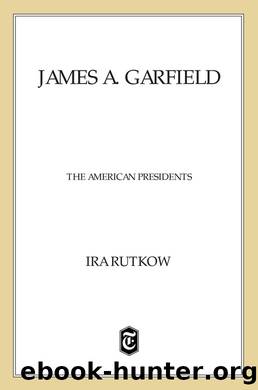James A. Garfield by Ira Rutkow

Author:Ira Rutkow
Language: eng
Format: epub
Publisher: Henry Holt and Co.
Published: 2012-07-24T16:00:00+00:00
8
The State of American Medicine
In 1881, American medicine was in the middle of a revolution. Fundamental developments in the medical sciences, including groundbreaking research in bacteriology, histology, pathology, and physiology, heralded a new era in clinical practice. Old-world herbal and mineral concoctions were abandoned in favor of modern pharmaceuticals. Centuries-old therapies, including bleeding, blistering, and purging, fell by the wayside, as physicians began to understand the relationship of bacteria, disease, and the publicâs health. The most critical qualities of modern medical thoughtâa scientific attitude, an openness to question past authority, learning from clinical experience, and the need to adapt therapeutic practices accordinglyâwere becoming mainstays of everyday clinical work. Americaâs healers were emerging from the restraints of ignorance and superstition to become world leaders in medical education and research.
Unfortunately, James Garfield would not benefit at all from this medical revolution. His doctors were mired in medicine of the past and could not conceive of diseases and treatments in anything resembling todayâs scientific terms. For Bliss and his minions, ancient remedies, old-world philosophies, and a stubborn resistance to scientific progress characterized their every deed and word. In their arrogance and hubris, they would bring about the death of a president of the United States.
At the time of Garfieldâs shooting, despite remarkable developments in medical thinking, the everyday practice of American medicine remained doctrinally divided. Two of the reasons for the discordâanimosities between rival physician factions and a closed-mindedness toward the use of antisepsisâdirectly affected Garfieldâs care. Until the 1880s, virtually anyone could call him- or herself a physician and treat patients. Americans embraced this laissez-faire style of health care delivery, and partially as a result of this lack of governmental regulation and control, alternative or sectarian medical groups emerged. They soon successfully lobbied for the repeal of the few state and local licensing laws that were biased toward the dominant medical orthodoxy. In 1847, responding to these challenges, a group of physicians founded an organization to function as a unifying body for traditional-style practitioners. This society, the American Medical Association, provided a sense of socioeconomic stability for its constituents at a time when the day-to-day practice of medicine was in managerial disorder. Despite its supposed mandate, the association held little official authority and, through the time of Garfieldâs presidency, no federal, state, or local licensing agencies provided well-defined legal standards for medical education, training, and practice.
As a consequence of this turmoil, in the years before and after the Civil War, unregulated orthodox and sectarian medical schools flourished. This medical mishmash meant that an individual could obtain a medical degree and tout himself as either a traditional-style or a sectarian-schooled physician. Even more confusing were the numerous cross-over doctors who switched clinical allegiances in mid-career. To the unschooled layperson, however, legal and scientific distinctions between orthodox doctors and sectarian physicians meant little when choosing a practitioner. In this prescientific era, a healerâs clinical identity and reputation were tied more to personal character and bedside manner than to medical know-how.
By 1870, there were two
Download
This site does not store any files on its server. We only index and link to content provided by other sites. Please contact the content providers to delete copyright contents if any and email us, we'll remove relevant links or contents immediately.
Einstein: His Life and Universe by Walter Isaacson(1332)
Finding Freedom: Harry and Meghan and the Making of a Modern Royal Family by Omid Scobie & Carolyn Durand(1186)
Promised Land (9781524763183) by Obama Barack(1162)
Compromised by Peter Strzok(1076)
Finding Freedom by Omid Scobie(1068)
JFK by Fredrik Logevall(1009)
Freedom by Sebastian Junger(649)
Salford Lads: The Rise and Fall of Paul Massey by Bernard O'Mahoney(593)
The Russia House by John Le Carré(572)
Kremlin Winter by Robert Service(537)
Day of the Dead by Mark Roberts(524)
Graveyard (Ed & Lorraine Warren Book 1) by Ed Warren & Lorraine Warren & Robert David Chase(516)
A World Ablaze by Craig Harline(513)
Flying Tiger by Samson Jack(511)
Joe Biden: American Dreamer by Evan Osnos(500)
100 Things Successful Leaders Do by Nigel Cumberland(482)
Melania and Me: The Rise and Fall of My Friendship With the First Lady by Stephanie Winston Wolkoff(482)
The Irish Buddhist by Alicia Turner(481)
The Mission by David W. Brown(467)
